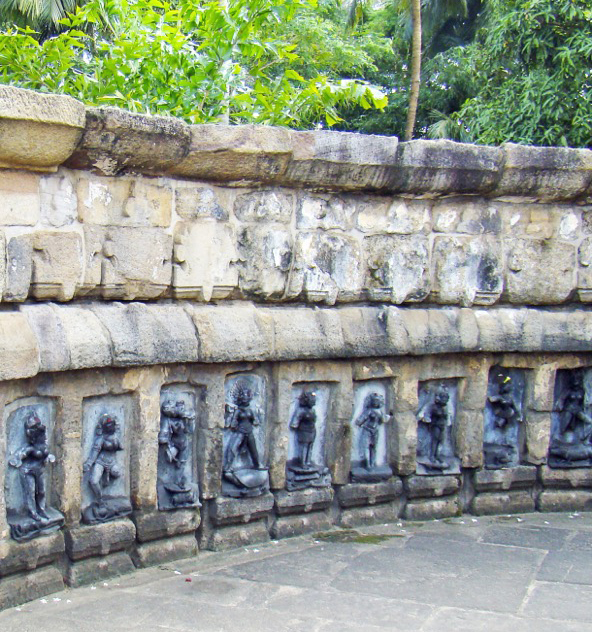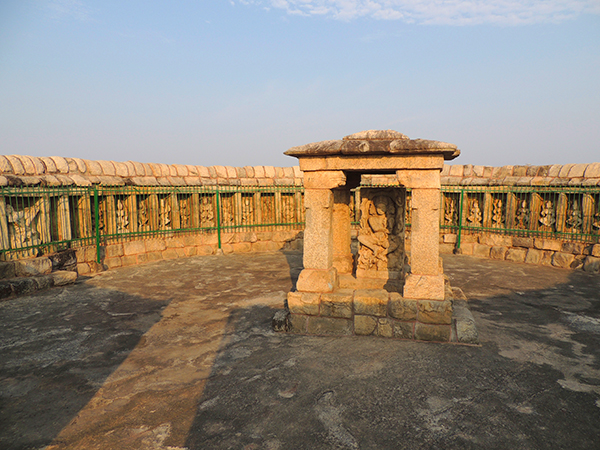When I came to India, I found that there are millions of ways to approach the divine. Many homes have their own devotional altar. The temples receive passing queues of people who want to give offerings.
The temple is often a caste-oriented structure, dominated by Brahmin men. Low caste people are usually not welcome to approach the inner sanctum. They communicate their religiosity in simple altars in open spaces. After I’d grown familiar with the two main architectural variations on sacred buildings—the cylindrical cupolas of the South and the pyramidal ones of the North—I was quite astonished when one day I found myself in a completely different type of temple.

This was in rural Orissa at Hirapur, not too far from Bhubaneshwar. The temple was a simple round stone structure open to the sky, with sixty-four female sculptures facing inward to the center. Entering the temple, I immediately experienced the energy of being surrounded by goddesses. My eyes closed and my body folded into a sitting position. I passed beyond the experience of the feminine creative energy around me and became one with everything and nothing at the same time.
Fascinated, I began ten years ago to study what I had found there in Hirapur—Yoginis—and their temples. Very few people knew about these open sky temples with large groups of goddesses and little had been written. In recent years, though, new translations of ancient manuscripts have come to light and traveling has become easier, giving access to remote sites in India. The Yogini Temples are among those rare and fascinating places that are now more accessible. The once-buried religious practices they represent can be revived.

One scholar, Dr Vidya Dehejia, published a comprehensive study on the cult and temples in 1986. Until then, manuscripts on the Yoginis had been translated by male Brahmin scholars in such a way as to be dismissive of the Yogini spiritual path.
After studying the temples and some of the manuscripts, I came to view the Yoginis as representing energies coming together in order to synchronize, empower, and refine the inner forces in the human body and the Universe. The “togetherness” likely gave the generic name to the Yoginis as it comes from the root Yuj that means joining, attaching, team, etc. To me, what differentiates the Yogini cult from those of self-standing goddesses is the vibrating power of the group.
The Yogini pantheon across India has an elaborate symbolic iconography that differs from one group of Yoginis to another, giving birth to systems of energy. These Yogini Chakras can be seen and felt in the Yogini Temples in Orissa (Hirapur, Ranipur Jharial) and in Madhya Pradesh (Bheraghat, Khajuraho, Mitauli, Dudhai).
Only the temples of Hirapur, Ranipur Jharial and Bheraghat still have Yoginis. In the other temples, like Khajuraho, Mitauli and Dudhai, the niches that once had the Yoginis are now empty. There are also some sites with no temples or ruins but where large number of sculptures of Yoginis have been found. These sculptures are now spread out among museums in India, Europe and America.

I had the opportunity to be involved in the translation of the Kaulajñananirnaya, an ancient tantric text that proclaims to carry the wisdom of the Yoginis. This experience gave me the idea of creating a way of presenting the esoteric concepts embedded in the text in a didactic and playful way, using a Yogini deck of cards with original Yogini drawings. The cards try to reflect the delicate and mysterious essence of the Yogini Knowledge.

Kausidyaharah. Artwork by author.
The cards convey not just the images of the goddesses, but some of the qualities of their settings. The temples were simple geometrical shapes, open to the sky, and simple in their external walls. In the interior, Yoginis were displayed around the inner walls, leaving space for the devotees to dwell with them. Cards can be laid out to similar effect.
The Yoginis often have an animal at their feet (vahana) and symbolic attributes and facial expressions, to transmit information to the observer. Their hands often hold tridents, skulls, severed heads, swords and shields. All these elements differentiate individual Yoginis as kind and benevolent givers of boons; or fierce protectors ready to kill or subjugate demons of fear, pride, jealousy, and laziness; or animal guides, implying the decapitation of our analytical minds in order to allow different animal intuitions to guide us in certain circumstances.

Simhala-Pada. Artwork by Author
According to the legends and ancient texts, the core of the tradition of the Yoginis was introduced to the world by Matsyendra-Pada, also known as Matsyendranatha. He came to be called The Lord of the Fish after a legend in which the Lord is reborn as a powerful Guru after being swallowed by a big fish. Abhinavagupta, the famous Tantra philosopher from the 11th century, honored Matsyendranatha as the Father of Yoga, probably for promoting the state of Unity (state of Yoga) with the help of the senses. The views of Matsyendranatha were different and innovative. Every colophon of the Kaulajñananirnaya proclaims his authorship (in different appellations).
In the text, the path of the Yoginis was presented as being beyond gender and caste. The teachings aimed to empower women and men in order to deal with the challenges of life and achieve the highest spiritual goals. Paying tribute to Brahmins was no longer required, and one did not have to be reborn as a ‘Brahmin man’ to have access to a spiritual life. Animosity toward Brahmin rules and ideas is evident throughout the Kaulajñananirnaya.

Bhojyani-Pada. Artwork by author.
In the beginning of the 11th century, when new invaders entered India, the Brahmins seem to have seized the opportunity to greatly diminish the influence of the Yogini knowledge.
The Yoginis needed ten centuries to see a revival of interest in all the different realms: scholarly, artistic, philosophical and spiritual. Over the past few years artists from around the world have begun creating new Yogini drawings and sculptures. Interpretations of their sacred path are being explored. Re-invented Yogini dances are performed in the temples and auditoriums around the world.
- The Triumph of the Yoginis - December 26, 2014


